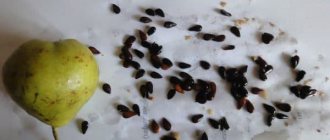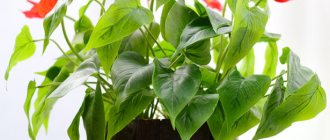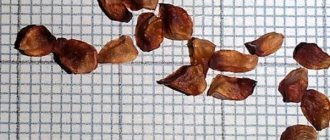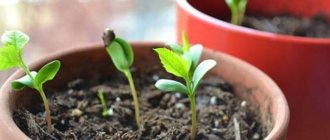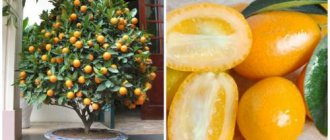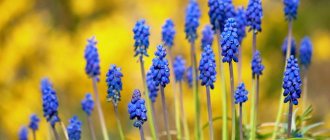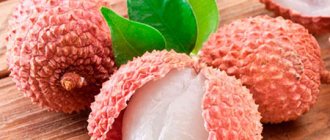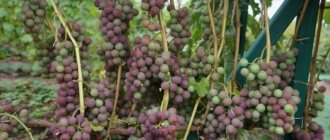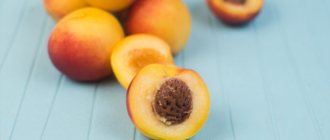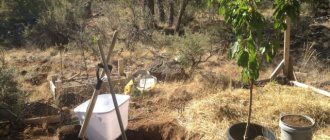Nectarine is a luxurious, aromatic tree that, when properly cared for, produces delicious fruits. Speaking about choosing suitable planting material for its cultivation, it should be noted that the simplest way is to purchase an already grown seedling in a specialized store or from generous gardener friends. And then after 3-4 years you will be able to get the first fruits. But if you are attracted by the opportunity to grow a tree from a seed practically “from scratch”, at home in a pot, you will find the features of this process below (photos and instructions are attached).
Correct sowing time
You cannot keep nectarine in a pot at home for too long, since the necessary growing conditions cannot be met in the apartment. Due to stagnation of dry air, with high humidity, spider mites may appear on the plant, or it will be infected with blackleg.
Nectarines
As soon as the window sills receive a lot of sunlight, you should open the windows more often so that the seedlings begin to get used to certain climatic conditions. In this case, they will get stronger faster and prepare for winter.
It is necessary to plant nectarines in open ground after the end of freezing. Sowing should be done:
- In the south of the Russian Federation - February-March.
- In the Moscow region - March-April.
- In Siberia it is April.
It is recommended to plant a month before the onset of warm weather.
Step-by-step algorithm for planting nectarines
The process of planting seeds is the same as traditional seed planting:
- Select a suitable container for planting.
- Buy or mix your own soil for planting.
- Plant the seeds, observing the depth of the soil.
- Maintain the conditions necessary for germination.
- Care for sprouts.
Timing of planting work
It is recommended to plant nectarine seeds in open ground in late summer or autumn. In this case, the seeds will undergo natural stratification over the winter, which will allow them to begin the growing season more actively in the spring. You can plant nectarines in the spring if you create artificial conditions for stratification. When growing seedlings indoors, to determine the planting date, you should know that the first shoots will appear from the soil after 4 months.
Preparing the container and soil
The root system of nectarine seedlings develops very quickly and requires a lot of free space. The growing container must have a large diameter and depth.
It is recommended to use tubs or large pots with a volume of at least 60 liters. To grow nectarines, it is important to choose fertile soil with neutral acidity.
The soil should be light and loose in order to allow water and air to pass through well. A mixture suitable for nectarines includes turf soil, peat, sand and leaf humus in equal parts.
Depth and rules for planting seeds
The sufficient depth for placing the seed in the soil is 5-7 cm. It is recommended to plant the seeds in small trenches at a distance of about 20-25 cm from each other. After filling with soil, plantings must be watered with warm water.
Where can I get bones and how to prepare them?
In order for a seed to sprout, you need to choose the right planting material. Some seeds do not germinate well, so it is recommended to take several to increase the likelihood of germination.
How to grow plums from seeds at home
It is recommended to choose seeds from late fruits, since their germination rate is higher. It is also worth paying attention to fruits that were grown in the Russian Federation. Otherwise, the tree will have to adapt to the conditions, which is why there is a high probability of death. At the same time, domestic fruits are less often treated with chemicals, which prevent the seeds from subsequently germinating.
Important! If your neighbors have a nectarine that has begun to bear fruit, it is recommended to take several fruits from them for subsequent planting. In this case, seed germination will be better.
Nectarine seeds
Externally, the fruit should be smooth and without signs of disease. The fruit must be taken overripe to increase the likelihood that the plant will be able to germinate.
Seed preparation
Growing trees from seeds is quite difficult. This will take a lot of time and patience. At the same time, nectarine is a capricious tree that is difficult to germinate from seeds. Only a quarter of the planting material can be successfully germinated.
First of all, you need to thoroughly clean the seeds from the pulp. After this, they must be soaked in water with the addition of a growth stimulator for 10 days. The water should be changed daily. The seed will germinate only after wintering. Therefore, the seeds obtained in summer and autumn need to be stored in the refrigerator.
How to grow nectarine from seed?
For those who love complex solutions and gardening work, growing nectarines from seed will be a real hobby. And the point here is not only in the selection itself and its nuances, but in the fact that before it begins, you should correctly and accurately select the main planting material that will meet all the necessary requirements.
In general, to select nectarine plant seeds you need:
- Buy or borrow from neighbors/friends ripe fruit;
- Carefully open the pulp and remove the seed;
- Check the planting material in detail and scrupulously for the presence of mechanical or biological damage;
- Dry the seed thoroughly (for several hours - this will be quite enough);
- After drying, the bone must be left in warm water for several days (from 4 to 7), periodically changing the liquid to fresh;
- The final stage in preparing nectarines for planting is stratification.
Having carefully gone through all the stages, any gardener who wants to grow a full-fledged, high-quality nectarine can already be 50% confident in the success of this venture.
Soil preparation
How to grow mangoes from seeds at home
Nectarine is not picky about the soil in which it grows. Therefore, you can choose a universal one from a special store, or mix the one on the site with humus and baking powder. Any substance can be used as a leavening agent:
- perlite;
- vermiculite;
- coconut fiber;
- river sand.
Both in open ground and in the substrate in the store there can be fungus and larvae. Therefore, the soil must first be disinfected. For this purpose, the soil must be heated in the oven a week before planting.
Necessary conditions for cultivation
In just one season, a nectarine sprout can turn into a tree about 1 m high. It will be too crowded on the windowsill, so you need to replant the plant in time. In addition, it is important to provide him with proper care.
In order for nectarine to grow quickly and not get sick, it is necessary to create comfortable conditions for it. This must be the right place to plant in the first place. Nectarine will be comfortable in the sun, where there is a lot of warmth and light.
In just one season, a nectarine sprout can grow up to 1 meter.
Do not forget that this plant loves water very much. Therefore, it needs to be watered in a timely manner. In order to get a good harvest, you should apply fertilizing. These can be special purchased fertilizers or natural resources.
Like peaches, nectarines need to be pruned periodically. But this should be done correctly, carefully following the recommendations of experts regarding a particular variety. Pruning of columnar nectarines is not required, since they take on a certain shape themselves.
[adsp-pro-6]
It must be taken into account that plant nutrition must be applied correctly and in a timely manner. Nectarine loves fertilizer, but it is not necessary to apply it in winter. This is the period when the plant needs rest. Otherwise, the nectarine will not be able to gain strength to form a large harvest. Fertilizing should be applied with the arrival of warm weather. These should be fertilizers with a large number of different microelements, for example, Agricol. Particular attention should be paid to fertilizing with copper.
How to plant nectarines yourself
How to grow apricot from seed at home
There are several methods for planting nectarines. You need to choose depending on your own care preferences, as well as the amount of time spent.
Bone in a pot with substrate
Cold germination
The seed needs to be planted in a pot to a depth of about 6 cm. The soil needs to be moistened and the pot placed in a cool place. For these purposes, you can lower the container into the basement, take it out to the balcony or place it in the refrigerator. The first shoots will appear after a long time. Care consists of regular ventilation and moistening of the soil. Shoots will appear 3-4 months after sowing.
Additional Information! This method should be chosen if planting is carried out in mid-spring. This will help avoid frost and temperature changes. After the sprouts appear, you need to move the pot to a warm place.
Warm germination
The process includes the same steps as in the cold method. However, the bone must first be stored in the refrigerator for a couple of days. The soil should be moist during planting. The pot must be placed under film. Sprouts will appear when there is enough sunlight and room temperature. The film needs to be changed regularly, and the crops need to be ventilated daily.
Stratification rules
Stratification is not the only way to sow nectarines, but it is the most reliable. Seeds must be sent for the procedure 3-4 months before planting. Step by step process:
- You need to wrap the seeds in a damp cloth and place them in a plastic bag.
- You need to make several holes in the bag using a toothpick so that air can get to the seeds.
- After this, you need to put the bag on the bottom shelf of the refrigerator.
- Regularly once a week you need to take out the seeds, wash them with warm clean water, and change the bag with a napkin.
Note! Seeds may germinate ahead of schedule. In this case, they need to be planted immediately and protected from pests and diseases. They can germinate due to the high temperature in the refrigerator - optimal up to 5 degrees Celsius.
Stratification
After this, it is necessary to break the integrity of the outer shell using a sharp knife, which must first be disinfected. After making a small cut on the shell, the seeds must be placed in a solution with a growth stimulator. They are usually chosen as Kornevin, Epin or Heteroauscin.
How to propagate indoor nectarine
Indoor nectarine can be propagated in two ways:
- By cuttings. To do this, select a branch that is at least a year old. Cut it so that the cutting size is 10-15 cm. Remove the lower leaves and place the cut side in water until the first roots appear. Then stick the seedling into the ground and water and spray regularly. If it takes root, it will produce new leaves.
- With the help of bones. We have discussed this method in detail. All that remains is to figure out how to collect the planting material yourself. Everything is simple here. Eat a nectarine, rinse the seed under water, and then dry it. That's all.
Want to do something else? Then see how to grow an avocado from a seed. The tree is no less interesting.
Propagation by cuttings occurs faster than by seeds
FAQ
Natalia Papanova
Blog author
Ask your question
Nectarine is an exotic fruit. Therefore, questions often arise about its cultivation. At one time they puzzled me. To prevent this from happening to you, I will share the answers.
Is it possible to harvest indoor nectarine all year round?
No you can not. The tree, as expected, will have periods of rest from fruiting.
Caring for sprouts at home
In order for seedlings to gain strength, it is necessary to create favorable conditions for their growth. They are not picky about the soil, but other parameters are important.
Temperature
The temperature regime is most important for the plant. The tree must be kept in an unventilated room at an air temperature of about 22-24 degrees Celsius. You should avoid drafts and sudden changes in temperature.
Provide lighting
If the plant doesn't get enough light, it can quickly wither. Therefore, in the autumn-winter period, it is especially necessary to provide additional lighting using fluorescent lamps and phytolamps.
Watering
The plant loves moisture, so nectarine needs to be watered regularly. Do not overfill it, as this may cause mold and mildew to appear. Watering is done with warm water, which must be well infused beforehand. In winter, when the plant is in a dormant period, the soil needs to be moistened less. You can resume your usual routine after the first buds appear on the tree.
Top dressing
Nectarine requires complex feeding. They can be bought at a specialty store or prepared at home. It is recommended to apply fertilizers to the soil in the spring and from the second year of the plant’s life.
To speed up the growth of a tree and protect it from diseases, you can prepare a certain fertilizer. It consists of:
- 1 g boric acid;
- 2 grams of copper sulfate;
- 5 grams of soda ash;
- a small amount of manganese;
- iodine drops.
The resulting mixture must be diluted in a liter of clean water. The solution must be sprayed on the tree twice a day until autumn.
Spraying nectarine
Note! In the fall, fertilizing should be stopped to allow the nectarine to independently prepare for winter and the dormant period.
Caring for nectarines from seed
Every gardener knows that in order to obtain a high-quality product, it is necessary to observe a sufficient number of conditions that promote normal adaptation, vegetation and subsequent fruiting of any plant.
The process of caring for small nectarine sprouts includes the following steps:
- High-quality ventilation of the room and free access of fresh air for the plant;
- Providing adequate and sufficient lighting for nectarine growing. If there is none (natural), it is imperative to resort to the help of artificial illuminators;
- Maintaining the temperature in the room. In winter - from 2 to 5 degrees, in spring - at least 13 degrees, in summer - at least 21 degrees;
- Periodic feeding of the plant using various fertilizers.
These steps are the primary steps when growing nectarines yourself at home. Further, when good sprouts have already formed and the plant has acquired the appearance of a full-fledged seedling, a caring owner should turn his attention to the high-quality formation of the crown through systematic pruning.
This nuance is especially important for subsequent fruiting, because its volume and quantity directly depend on the timely removal of excess shoots and a correctly formed crown.
With proper care, a gardener should not have any problems growing an exotic plant, but often, due to inexperience or inattention, they break some rules, and the plant begins to get sick or even dies.
How and when to transplant a tree into open ground
It is necessary to prepare in advance the place where the tree will subsequently grow. Preparation is carried out in spring or autumn. You need to choose a sunny place that is not flooded by melt water. In winter, snow should accumulate in this place in large quantities, which will cover the tree and protect it from frost. A suitable location is available next to the building.
Fertilizers made from humus and ash should be sprinkled on the garden bed. The latter can be replaced with superphosphate or potassium sulfate. Step-by-step transplant process:
- Make holes the size of pots to contain the sprouts. It is necessary to follow a certain planting pattern: there should be at least 30 cm between rows, and 15 cm between bushes.
- Transfer the sprouts with a lump of earth into the hole and cover with substrate.
- Water.
- Gently compact the soil and mulch.
Subsequently, it is necessary to properly care for the seedlings so that they quickly grow and begin to bear fruit.
Cultivation
Planting nectarines on the site begins with preparatory work. The vegetation of the plant depends on how they are carried out.
Requirements for the selection of planting material
The collected nectarine fruits must be overripe for planting. Pay attention to the pulp. Suitable material is one that is not damaged or rotten. Peaches that are infected with pathogenic fungi and viruses cannot be used for cultivation. The bone inside should be intact and even in color. It is washed several times to remove any remaining pulp from the grooves on the surface of the shell.
See also
The best ways to propagate peach and the rules of agricultural technologyRead
Preparing seeds for planting
Separating the seed from the seed requires care. First, the bones are filled with warm water and left for several days. The water must be changed regularly. Then drying begins. Place the material on a tray and place it in a well-ventilated and bright room.
You can determine the readiness of the seed material by cracking the nut. It is better to place the bone on the rib and hit it with something heavy. The nectarine kernel must not be damaged during the operation.
When you plan to plant directly in the ground in the fall, you don’t have to soak the seeds. For the spring procedure, keep the planting material in a box to prevent damage. In February, you need to soak nectarine seeds in plenty of water. Then they are placed in a plastic bag with damp moss or sawdust and sent to the refrigerator.
Care after planting in open ground
After a season, the nectarine will grow into a tree up to 1 m tall. After planting in open ground, the tree will require some care. In order for nectarines to continue to grow quickly, they need to create comfortable conditions. For these purposes, when planting, you should choose a sunny place.
The plant loves moisture, so it needs to be watered regularly. To obtain fruits, it is necessary to fertilize in a timely manner. You can buy fertilizers at a flower shop or make your own.
Note! Nectarines need pruning. It is recommended to seek professional help as the method for removing branches depends on the type of tree. The exception is columnar nectarines, since they take on the desired shape on their own.
Choosing the right seed
For planting, it is better to take seeds from nectarines grown in Russia.
In order for a seed to sprout, it is necessary to choose the right starting material. Nectarine seeds germinate very poorly, so you need to prepare several at once, which will increase the likelihood of getting sprouts and later seedlings.
When choosing a seed, you must pay attention to the variety of the fruit. It is important that it is a nectarine that was “born” in Russia. Otherwise, it will be too difficult for the plant to adapt and it will not survive even if it germinates. Moreover, domestic fruits are less likely to be subject to chemical treatment, after which it will not be possible to grow a tree from a seed. Experts note that the closer the tree is located, the higher the likelihood that its seeds will sprout. Therefore, it is best to choose fruits grown by neighbors, if possible.
As for the nectarine itself, it should be smooth, beautiful and free of signs of disease. The fruit must be completely ripe, or better yet, overripe. This will increase the likelihood of germination.
Mistakes in growing nectarines
Beginning gardeners worry more about how to plant nectarines than about proper care for them. The tree needs careful care, especially in the first year of life. It needs to be protected from frost using insulation that is tied around the branches and trunk. The main mistakes include:
- incorrect disembarkation dates;
- lack of ventilation;
- improper organization of the greenhouse;
- choosing the wrong variety;
- waterlogging;
- excessive amounts of fertilizer.
Nectarine pruning
A healthy tree should not shed its leaves for a long time. If this starts happening too early, you should sound the alarm. If leaves fall off while the fruit is growing, fungal diseases may be the cause. You can prevent such developments by timely spraying the tree and sanitary pruning.
Prevention of diseases and pests
Let's talk about diseases and pests of nectarine. In order to help the plant in time, you need to know how to recognize the disease and how to eliminate it.
Moniliosis
A fungal disease that affects fruits and foliage. It can be recognized by the presence of dark spots that appear on shoots or crops. Over time, these spots grow and become very extensive. The tree stops growing and developing. If nothing is done, the disease can destroy a healthy tree in a couple of months.
To fight, I recommend using “Topaz” or “Chorus” products. The first is diluted in a proportion of 2 ml per 5 liters of water. The second is 4 g per 10 liters of water. Both products are sprayed over the surface with a spray bottle. Repeat the procedure again 2 weeks after the first treatment.
You can see why moniliosis appears and how it spreads in the video below:
If you don’t want to deal with such a disease, then read how to grow pineapple at home. This exotic plant has a high immunity to moniliosis.
Leaf curl
An infectious disease. Young shoots and leaves are affected. Massive deformation of the leaf plate and shoots begins (they curl). Nectarine stops bearing fruit because the entire ovary falls off in the affected areas.
For treatment, use Bordeaux mixture. Dilute in a proportion of 40 ml per 10 liters of water and spray over the surface. You can repeat the procedure after 1-2 weeks. But usually this is not required: the disease goes away.
Powdery mildew
A fungal disease that affects the entire tree. A sticky white coating appears on the tree, it begins to wither and is severely retarded in growth. If nothing is done, the nectarine may die.
“Topaz” copes well with powdery mildew. It is applied in the same proportion as for moniliosis.
If you notice a sick tree, isolate it from healthy specimens
Pests
Among the pests, the two most common are scale insects and peach aphids.
The first parasite is a small insect up to 3 mm in size. Outwardly it looks like an aphid, only its back is covered with a hard shell of brown or gray color. The larvae suck the juice from the plant, it begins to wither and gradually lag behind in growth.
The second pest settles in colonies. The size does not exceed 1.5 mm. Color: light green. Also refers to the sucking class. As a result of an aphid attack, the tree dries out and dies over time.
To combat these parasites, I recommend using Corado. To prepare the working liquid, dilute 1 ml of the drug in 8 liters of water and spray the tree. No re-processing required.
Such pests are not dangerous for the already harvested crop. Find out how to store zucchini at home. There will be no problems with insects here.
Diseases, pests and possible difficulties during cultivation
To grow nectarines or peaches in central Russia, it is necessary to regularly treat them against diseases. Most often the plant is affected by scab, moniliosis, fruit rot, and clusteropsoriosis. Pests also do not bypass the fruit tree. They are making an attempt on him:
- aphid;
- thyroid gland;
- codling moth;
- spider mite
Note! The fight against pests and diseases can be lengthy, so it is recommended not to neglect the rules of prevention. It is recommended to regularly carry out anti-aging pruning and spraying with fungicidal solutions.
The right approach will help you get healthy nectarines at home, which will delight you with delicious fruits for many years. However, fruits can only be obtained 3-4 years after planting in open ground. It depends on the conditions in which the tree grows.
Nectarine varieties for growing in an apartment
Let's find out which variety is best to plant. To be honest, it was difficult for me in this matter. Firstly, I didn’t even know where to get planting material. Secondly, I realized that there are too many varieties of nectarines. And I didn’t understand anything about it. Therefore, I decided to make a comparative description of the varieties that attracted my attention. To make it easier for you, I am sharing the result of my research.
You can see other common varieties in the video below:
| Name | Characteristic | pros | Minuses |
| Nectarine 4 | The tree is medium-sized - from 1.5 to 2 m. Abundantly covered with light green foliage. The shape of the fruit varies from round with an elongated base to oval. The weight of one full-fledged copy is 140-160 g. | The stone is easily separated from the pulp. The tree bears fruit regularly and abundantly. The fruits are large. It is resistant to frost, drought and fungal diseases. The variety is not demanding regarding care conditions (location, watering, temperature, etc.). | It is difficult to find seed for sale. I looked for it on the shelves of our stores, but, alas, I couldn’t find it. If we talk about the Internet, then there are seeds for planting, but their quality is questionable. In order for the tree to bear fruit, regular feeding is required. |
| Crimson Gold | A hybrid variety. It reaches a height of up to 1.5 meters. The fruits are completely smooth and large (one weight is 130 g). Color - dark red with burgundy admixtures. Ripens early. You can get the first harvest already 3 years after planting. | Excellent taste and pronounced fruity aroma. Very juicy fruits. The tree is frost-resistant and high-yielding. It looks compact in the room and does not take up much space (the branches are not spreading). | The fruits do not tolerate transportation well and spoil quickly. Does not like waterlogged soil. |
| Fantasy | The fruits are round in shape. A distinctive feature is its golden yellow color with dark red streaks. The skin is completely smooth. Size - from medium to large (from 130 to 180 g). | The pulp is sweet, with a wonderful aroma. The variety blooms profusely, the fruits begin to ripen early - 3-4 years after planting the seed. It can be consumed both fresh and processed. Keeps well frozen (in the freezer, for example). | Despite the fact that the variety is characterized by abundant flowering, the ovary process is poor. So you either need to pollinate by hand or be content with a small harvest. The tree is demanding in terms of care. Does not tolerate careless handling. |
| Ruby 7 | A medium-sized tree - up to 1.5 m, with spreading branches. Fruits abundantly. Nectarines are small (100 g each). The skin color is dark red. There is fluff. | The variety is unpretentious in care. It bears fruit regularly. Maturity occurs early - already 3 years after planting. Tolerates temperature changes, climate change and drought well. | Since the branches are spreading, it takes up a lot of space in the house. To control their growth and development, you will have to trim them. The bone is difficult to separate from the pulp. Susceptible to fungal diseases. |
| Scythian | The tree grows quickly - if not controlled, it can grow up to 5 meters. The shape of the fruit is spherical. The skin is elastic, dense with fluff on the surface. Size - large (up to 180 g). Color - bright red with a yellow blush. | Tolerates transportation well. The harvest is stored for a long time. It is resistant to fungal and bacterial diseases, as well as pests. The pit comes away from the pulp without effort. | The tree is tall and needs to be pruned regularly. It begins to bear fruit late - 4-5 years after planting. Does not tolerate sudden changes in temperature, cold and waterlogging. |
| Crimean | The tree is of medium height - up to two meters. The fruits are dark red, oval in shape with smooth contours. Without a gun. The color is crimson, the flesh is yellow. The harvest is large - up to 160 g. | It begins to bear fruit very early (already 2-3 years after planting). The fruits are elastic and dense, so they are suitable for long-term storage. They can also be used for making juice, compote, jam and other preserves. | Has low immunity to various types of diseases. Requires care: does not tolerate drought and waterlogging, it is important to monitor the watering regime. Although the fruits are large, the yield is not very high. |
| Lola | In terms of sugar content, it ranks first among other varieties. But at the same time it has a specific spicy-sweet taste. The fruits are small in size (only 80-100 g). The color is greenish-cream with dark red veins. It does not grow more than 1.5 m in height. | Interesting and quite specific taste, juicy pulp. Abundant fruiting. Easy to care for: tolerates climate changes well. The bone is easily separated from the pulp and is suitable for both fresh consumption and canning. | The fruits are soft, so they won’t last long. Low immunity to diseases. The ovaries are poorly formed, although the flowering is abundant. |
Author's note
Natalia Papanova
Blog author
High-quality planting material can be obtained from nurseries specializing in this crop.
Don't want to plant nectarines? Start growing pomegranates at home. You will definitely like this exotic.
I chose the “Nectarine 4” variety for growing. The fruits look like this
Growing in the country
The best time to plant a peach in the ground is the last ten days of October and the first half of November.
You first need to prepare the seeds: either soak them in water or scarify them. To do this, slightly file the shell or slightly prick it with a hammer. There is no need to remove the seed completely. If weather conditions are favorable, you can sow the seeds in open ground. Planting depth is 7–8 cm
Choose an open and sunny place - this is an important condition for peach. Fill the holes with soil, mulch and mark with pegs
There are 2 classic peach planting schemes.
- There should be a distance of 3 meters between growing trees. This way the tree will eventually form a full-fledged crown.
- “Meadow garden” scheme - peaches are planted in a row. The distance between rows is 2 meters, between seedlings - 0.5 meters. So each tree will produce up to 15 fruits. Planting peaches according to the 'meadow garden' scheme
The peach should not be pruned in the first year of life; it should grow freely to create a full-fledged central shoot. Water the tree regularly and feed it with complex fertilizers.
In the second year of life, the formation of the peach crown needs to begin. In April, when sap flow begins, shorten the axial shoot to form a trunk. In summer, you can thin out the most advanced shoots.
Peaches planted in the “meadow garden” do not form a standard. Make spring pruning, leaving two shoots at a height of 10 cm from the soil. One of them will grow to bear fruit, the second will act as a reserve. By the end of autumn, cut off the fruiting shoot so that the second one begins to bear fruit fully. It also needs to be pruned, leaving two shoots: the main one and the spare one. This pruning pattern should be used in subsequent years. It is called the “fruit link principle.”
Plant varieties
There are several varieties of nectarines, which differ in the period of fruit ripening, yield and other characteristics. According to the timing of fruiting, early, middle and late varieties are distinguished. When choosing a suitable variety for cultivation, it is worth familiarizing yourself with the common types among experienced gardeners.
Early varieties
It is recommended to plant early ripening trees in regions with a short warm period. The following early varieties are popular among gardeners:
- Crimson Gold. Hybrid medium-sized variety with high yield. The fruits are large in size and weigh 120-130 g. The fruit pulp is tender and juicy.
- Big Top. The variety bears large oval-shaped fruits. The fruit has a sweet taste and is easily separated from the stone.
Medium varieties
Many gardeners prefer to grow medium varieties in temperate climates. Common medium nectarine varieties include:
- Wang. The variety is valued for its high yield and easy care. The fruits have delicate yellow flesh with a pronounced aroma.
- Flavor Top. A mid-season variety that bears fruits weighing 150-160 g. The main advantage of the variety is good transportability.
Late varieties
Planting late-ripening varieties is advisable in hot regions. In this category, the following varieties are in demand:
- Stark Red Gold. Trees with one crown bear symmetrical fruits with a round shape and weighing up to 200 g. The pulp is dense, easily separated from the seed. The harvest ripens in mid-August.
- Crimean. On compact plantings, at the end of the summer period, fruits weighing 190 g grow. During the year, 40-50 kg of harvest can be obtained from one tree.
- Columnar. Nectarines of this variety grow on small trees. The fruits are formed densely, which allows for a large harvest.
Description of the nectarine tree and the procedure for growing it from the seed
“Nectarine” means nectar, which indicates the high content of sugary substances in the plant. Nectarine and peach trees are similar to each other, as is the technology for their cultivation.
Nectarine is a large tree, reaching 5-7 m in height.
The tree is thermophilic. Only with an abundance of warm and sunny days can you get sweet, fully ripened fruits. Nectarine can withstand low winter temperatures, but already at -22°C the flower buds are damaged.
There are people who want to quickly see a grown fruit tree and get a harvest. They will buy a seedling and after 3-5 years they will begin to receive tasty fruits. But there are also those who want to go through the entire thorny path of growing a tree from start to finish. For example, start with a bone; below we provide instructions on how to do this:
Find a tree with already ripened nectarine fruits and pick a few of them. The fruits should be large and healthy. Separate the seeds from the pulp and check their quality: they should be without cracks or damage. Then each seed must be dried for a couple of hours. The next stage is soaking in water for 4-6 days.
In this case, the water needs to be changed periodically. Next comes the process of stratification, which will speed up the germination of the seed.
Please note that all seed germination activities are carried out in late autumn. The seeds are placed in wooden boxes with drainage holes to prevent excessive waterlogging and the seeds from rotting. Planted in a damp mixture of river sand and sawdust. The container (box) is buried in the area flush with the ground, and covered on top with a thick layer of straw and sawdust
This is necessary so that the planted nectarine seeds do not freeze in the winter. After the snow falls, they cover it with more snow on top. In such cool conditions, the seeds overwinter. In the spring, the box is removed from the soil and they germinate in the warm sun. Germination rate is usually low and amounts to 20%, so there should be a lot of seed material in stock. First the root appears, and then the leaf. Small seedlings need to be well watered. You can feed it with organic fertilizers. When they get stronger, they can be planted in pots or soil (depending on the desire of the gardener).
We looked at the main steps and figured out how to grow nectarine from a large but hard seed.
https://youtube.com/watch?v=zISVjTezkdo
Popular varieties
s020.radikal.ru ” src=”https://qlumba.com/wp-content/uploads/2019/07/fmg5d411a11822531.jpg” alt=”table_pic_” w /> Kievsky
- High-yielding variety of medium growth.
- Withstands frosts down to -27-33°C.
- Fruits weigh on average 85-140g.
- Harvest occurs in mid-July
shoni.kiev.ua ” src=”https://qlumba.com/wp-content/uploads/2019/07/fmg5d411a12ea08c0-2000×1500.jpg” alt=”table_pic_” w /> Stark red gold
- Medium-sized, high-yielding tree.
- Winter hardiness is above average.
- The same fruits weigh on average 180-200 g.
- Harvest occurs in mid-August
cado4ek.com.ua ” src=”https://qlumba.com/wp-content/uploads/2019/07/fmg5d411a203e2920.jpg” alt=”table_pic_” w /> Fantasy
- Early ripening variety.
- It has high winter hardiness and good immunity to pests and diseases.
- The fruits are round and weigh from 120 to 180 g.
- Harvest is harvested in June-July
Tree propagation methods
Nectarines are propagated in three ways:
- cuttings;
- seeds;
- vaccination.
Each process has its own characteristics and a certain technique that must be followed in order to achieve a good result.
Seeds
This is one of the easiest ways to propagate nectarines. However, not all seeds sprout. After harvesting, the strongest and largest fruits are selected. They are left to ripen. When the skin becomes thin, the seeds are removed. The following procedures are followed:
- The drupes are soaked in warm water for 2-3 days, this will help to germinate the seeds.
- The liquid temperature should be 50-60 °C.
- The water is changed 2 times a day, in the morning and at night.
- Then the seed material is removed and dried for 3 days.
- The seeds are extracted from the seed.
The landing procedure has its own characteristics. First you need to choose a suitable area with good lighting and suitable soil. Next, the following manipulations are carried out:
- Dig a trench 1 m long and 25 cm deep.
- Fill it halfway with humus.
- Pour water over and leave for 1 hour to absorb.
- Place the seeds in the hole at intervals of 30 cm.
- Buried with earth.
- The top of the planting is covered with any mulch.
- After 2-3 days, water with humus solution.
Important! Planting seeds can be done at any time: spring, autumn or summer. During the winter period, grains with poor germination will die, leaving the strongest ones.
Cuttings
After pruning, twigs remain that can be used to propagate nectarines. They should not be thicker than 10 mm. Each cutting is shortened to 15 cm. Shoots can be planted in spring or autumn. For this:
- Young shoots are treated with Kornevin solution to accelerate the formation of roots.
- Then they are planted in a suitable area in the ground.
- Cover with a transparent container, creating a mini-greenhouse.
- Leave the seedlings for 2-3 weeks.
- Check for the presence of roots.
- If the roots begin to grow, then they continue to grow the plants.
- If the bottom of the cutting turns black, it is removed.
See also
Description of the Kiev Early peach variety, planting and care rules
Read
Graft
This is a quick way to propagate nectarines, which most often ends in success. The scion is produced on peach or almond using the budding method. To do this, certain rules and conditions are observed:
- The thickness of the cutting for the rootstock should be more than 8 mm in diameter.
- The bark at the graft site of the mother tree is thin, smooth, and elastic.
- The procedure is carried out during the period of active movement of sap along the trunk.
- Only well-sharpened and sterile instruments are used.
Nectarine grafting is carried out according to a certain algorithm:
- Cuttings are harvested in the morning; their length should be at least 25 cm.
- Trim side shoots and leaves.
- They are lowered into the water.
- The branches are wiped with a damp cloth to remove dust and dirt.
- A transverse incision 12 mm long is made on the cutting.
- This incision is then made above the kidney.
- With a smooth movement, cut off the bark from one notch to another.
- A 2.5 cm long cut is made on the mother tree, being careful not to damage the bark and trunk of the tree.
- Then the cutting is applied to the tree, closing them with bare areas.
- Next, the attached shield is wrapped with plastic film.
- Leave for 2 weeks.
Important! After the grafting period has passed, the cutting should fall off when touched lightly. This indicates the success of the procedure.
Planting nectarine
When to plant nectarine
The further south you live, the more reason you have to plant nectarines in the fall. In areas with cold winters, spring planting of nectarines is preferable. In the south of Ukraine and Crimea, nectarines can be planted in the spring, or in the fall. The optimal soil for nectarine is loamy and sandy loam soils, and the worst option for it is heavy clay soils. Areas where groundwater lies too close to the surface, as well as those where nightshade or melons, alfalfa, clover and strawberries have recently been grown, are not suitable for nectarine - the risk of nectarine being infected with verticillium is too great.
The best place for nectarine is a site facing south, where it will not be shaded from the sun by buildings and other trees - nectarine should not be in the shade for more than 1.5-2 hours a day. The proximity to a peach is also undesirable, since the likelihood of nectarine becoming infected with fungal diseases increases, even those that may not cause much harm to the peach.
Planting nectarines in autumn
Before planting a peach in the fall, two to three weeks before planting, dig a hole measuring 70x70x70, drive a stake about 1.5 m high into the center of the bottom, mix the top layer of discarded soil with 10 kg of rotted compost and 150 g of superphosphate, mix thoroughly and Pour half of this soil mixture into a heap in the center of the hole.
When purchasing planting material, give preference to annual seedlings of those varieties that are adapted to your area. You must make sure that the tree is healthy: the nectarine bark should be green on the inside, the root system should be free of dry or rotten roots, and the grafting site should be free of swelling.
Place the seedling on a mound in the center of the hole, carefully straighten its roots and fill the hole with fertile mixture. When planting, nectarine seedlings should be positioned so that the grafting site is 3-4 cm above the surface level
After planting, compact the soil from the edges of the hole to the center, water the tree with 4-5 buckets of water, wait until the soil settles and the grafting site is level with the surface of the site, then tie the seedling to a peg, cover the nectarine trunk with dry soil to a height of 20-30 cm and mulch tree trunk circle for the winter with a layer of compost 8-10 cm thick.
How to plant nectarines in spring
If you plant nectarines in the spring, it is still better to prepare a hole for it the previous fall. The procedure for preparing the hole is the same as for autumn planting, and the planting procedure itself is no different. The only thing you won't have to do in the spring is hill up the nectarine trunk.
Nectarine in your garden
Nectarines are propagated mainly by grafting (budding). At the same time, they retain all varietal characteristics.
The best rootstocks for nectarines are peach and common almond. And on heavy, waterlogged soils with close (less than 1.5 m) standing groundwater, seedlings of cherry plum or domestic plum can be used as a rootstock. However, they are not compatible enough with some varieties of nectarines.
In order to grow nectarines from seeds, it is necessary, if possible, to pay attention to the nectarines growing on your plot or on the plots of your neighbors, and see which ones are more stable and productive. Next, you should select the seeds of the largest ripened fruits. Nectarine seeds can be planted in summer, autumn and spring away from mature trees (3 - 4 m) and the shade of the house
The planting site should be sheltered from cold winter winds with sufficient sunlight.
Next, you should select the seeds of the largest ripened fruits. Nectarine seeds can be planted in summer, autumn and spring away from mature trees (3 - 4 m) and the shade of the house. The planting site should be sheltered from cold winter winds with sufficient sunlight.
In the south, in order to grow nectarine from a seed, nectarine seeds without shells can be planted immediately after picking the fruit from the tree. To do this, remove the seeds from nectarine fruits and soak them for at least three days. The water in which the nectarine seeds are located must be changed at least twice a day. After the seeds have been soaked in water, they must be dried so that direct sunlight does not fall on them.
Next, the dried nectarine seeds must be opened very carefully so as not to damage the seeds. To do this, place the nectarine seed on its edge and carefully crack it open with a few blows of a hammer.
In order to grow nectarines from seeds, they are planted in a kind of school. To do this, dig a trench, fill it with fertile, fertilized soil, plant nectarine seeds to a depth of 5–6 cm with a distance of 20–25 cm and water abundantly. For the winter they are well covered (sawdust, leaves, grass, etc.).
To grow nectarines from seeds, you can also plant them before winter; during the cold period, the seeds will undergo stratification (aging) and self-select. However, nectarine seeds should not be soaked.
It is better to plant nectarine seeds in October or November and also cover them well for the winter.
In spring, you need to remove the covering layer, leaving a few centimeters so that the soil does not dry out. From a nectarine seed, a root is first formed, and only later a stem is formed. Therefore, the soil needs to be loose, soft and fertilized.
Nectarine seeds need to be watered daily.
It is advisable to feed the seedlings with diluted humus and spray them with special preparations (Ridomil or Tiovit); small nectarines, like peaches, are very painful.
If you decide that you will start growing nectarine from seed in the spring, and there is a danger of damage to the seeds by rodents, then store the nectarine seeds indoors until December - January, and then stratify. To do this, one part of nectarine seeds is mixed with three parts of a substrate of sawdust, sand or a mixture of sawdust and sand, moistened and placed in a plastic bag or clay pot, placed in a cool room or put in a refrigerator with a temperature of plus 3 - 5 °. During the winter they are periodically moistened to maintain constant moisture. Sprouted nectarine seeds are sown in the ground.
Nectarine seedlings are well looked after and watered. Already in the third year, seedlings can bear fruit.
However, it should still be remembered that when growing nectarines from seeds, trees with the same fruits from which the seeds were taken do not always grow.
Nectarine pruning
What time to prune
Nectarines require formative pruning. Fruiting in this plant is observed on annual shoots, so during regular pruning it is very important not only to maintain plant hygiene, but also to ensure intensive growth of annual shoots while preventing fruiting from shifting to the edge of the crown. It is because of this that it is necessary to annually thin out and shorten the branches of this plant. The first pruning of a tree planted in autumn will be needed only with the onset of next spring before sap flow begins. In spring, young plants need formative and sanitary pruning. In autumn, sanitary pruning of nectarines is carried out only when necessary.
How to trim a nectarine
As a rule, the crown of a tree is shaped like a vase or bowl. Thanks to this shape, the crown becomes stronger, and it is also easier to remove fruits from such a plant and easier to care for. The formation of the crown is carried out in the spring during the first 4–5 years. First, skeletal branches are laid. In the first year, it is necessary to select 2 or 3 branches with a wide angle of origin; they are shortened to 10 centimeters on the outer buds, while all other branches must be cut out. Every year you should add 2 or 3 skeletal branches, which should be located at the desired angle. Form a first-order branch on last year’s skeletal branches, a second-order branch on those from the year before, etc.
While the crown is being formed, the conductor should rise 0.2–0.25 m above the uppermost skeletal branches. After the crown formation is completed, the conductor must be cut to the level of the upper skeletal branches. The optimal height of the trunk is from 0.5 to 0.6 m. The shoots that appear in the area of the trunk must be broken out, and it is necessary to have time to carry out this procedure before they become lignified. There are gardeners who prefer the standardless form; in this case, skeletal branches can extend from the trunk almost at the very surface of the soil. This form helps to inhibit the growth of nectarines for a long time, and it also makes picking the fruits and caring for the tree much easier, since in this case a ladder is not needed. The recommended height of such a plant is from 250 to 300 cm.
Pruning nectarines in spring
In April, formative pruning of the nectarine is carried out on the pink bud, as well as sanitary pruning; for this purpose, all dried, injured, frost-affected or disease-affected branches are cut out. At this time, pruning is also carried out for fruiting; for this, 2 correct developed shoots should be selected on the skeletal branch, which grow side by side. The shoot growing closer to the top of the branch should be shortened by 8–10 buds; it should bear fruit this season. Another shoot, located closer to the trunk, must be greatly shortened so that 2 buds remain; a shoot will appear from this replacement knot, which will bear fruit in the next season. “Right escape” - what is it? This shoot has fruiting and growth buds (producing foliage). It is necessary to form a new fruit link from the replacement knot next season. In a similar way, the tree is pruned every year in the spring, as a result of which the harvests will be stable and the fruits will be of high quality.
At the end of flowering and the shedding of excess ovaries, it is necessary to adjust the crop load. So, on a branch there should be only 1 fruit for every 10–15 centimeters of length, and excess ovaries must be removed by plucking.
How to prune in summer
If the tree bears fruit, then it is not pruned in the summer. But at this time, unnecessary stems are pinched or broken off, this will stimulate the growth of new branches and the formation of fruit branches.
How to prune in autumn
When all the leaves have fallen from the tree, sanitary pruning is performed if necessary. To do this, cut out all weak, dried, injured and diseased stems.
